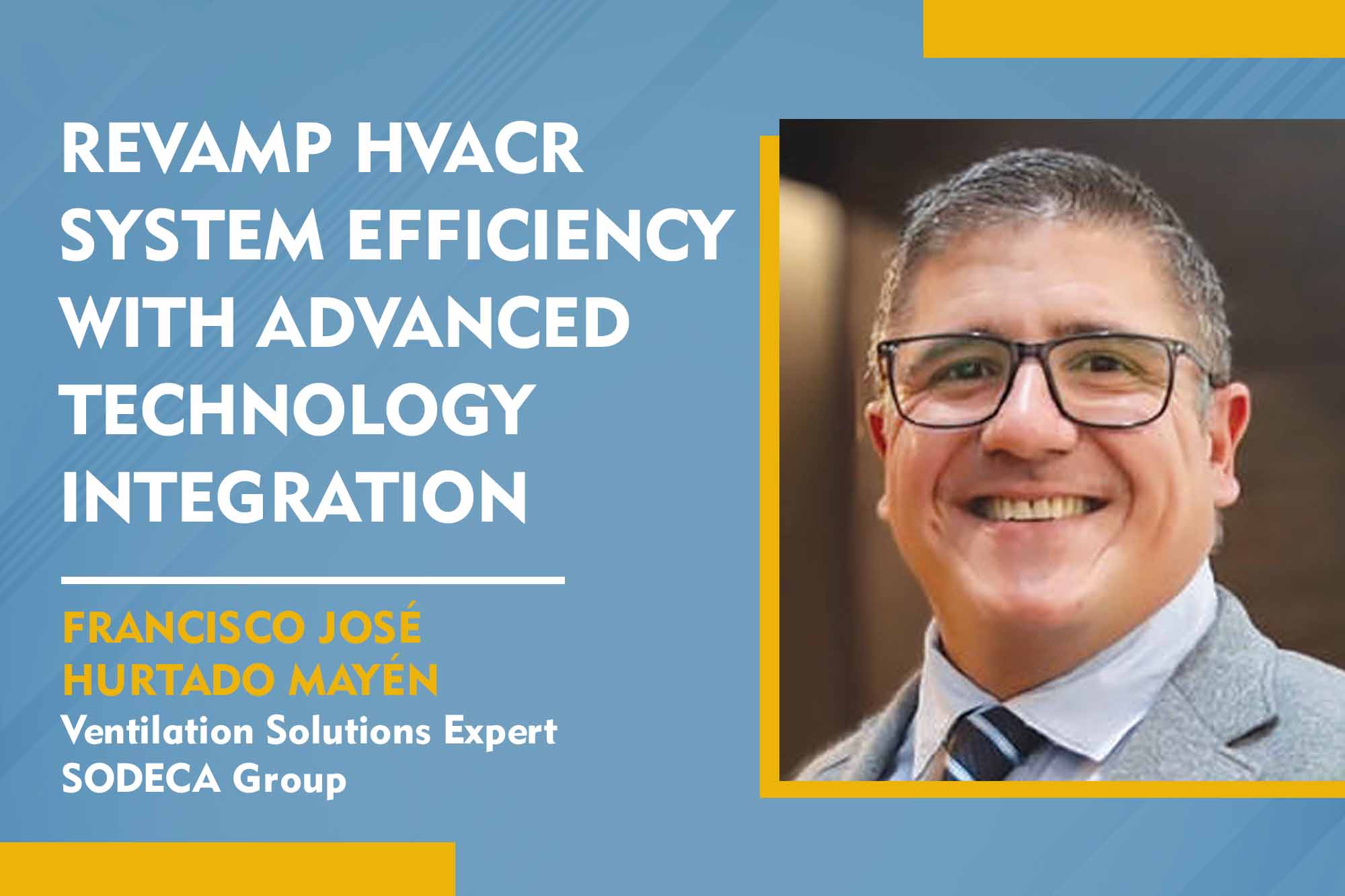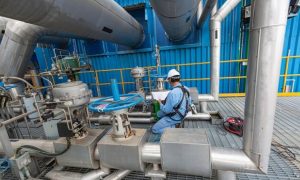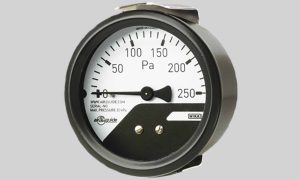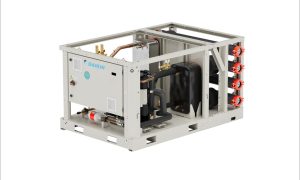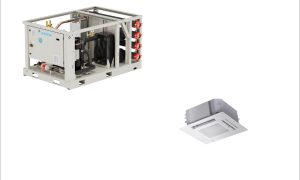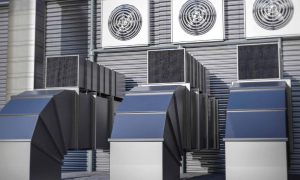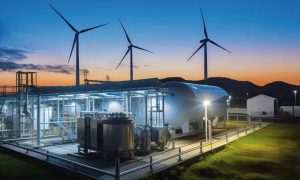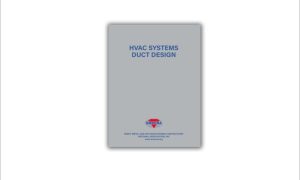The HVACR industry is currently experiencing a significant transformation driven by the need for energy efficiency and sustainability. As a ventilation specialist at SODECA, Francisco José Hurtado Mayén is deeply involved in the continuous evolution of HVACR technologies. In this story, he provides an overview of the advancements and trends shaping the field.
The HVAC&R industry is witnessing a transformative era marked by groundbreaking innovations focused on sustainability and efficiency. The industry stands at the forefront of innovation, particularly with the development of variable-speed fans. These fans are not just a system component; they are the heart of energy efficiency efforts.
A deep dive into energy efficiency
The adjustment of fan speed in alignment with the real-time ventilation demand markedly cuts down on energy consumption. This leads to decreased utility bills and prolongs the lifespan of the entire system by reducing mechanical strain and deterioration.
Fan technology and intelligent controls
Technological advancements characterise the transition from conventional fixed-speed fans to contemporary variable speed models. The most recent models feature cutting-edge motor designs that are both durable and energy-efficient. These motors are often equipped with permanent magnets or are electronically commutated, which contributes to their high efficiency and quiet operation.
What truly sets these fans apart are their intelligent controls. These sophisticated systems can assess different environmental and system factors to make real-time adjustments to fan speed. This level of control ensures that the fans operate at optimal efficiency, providing the necessary airflow only when needed. The impact of variable speed fans on energy consumption is profound. By optimising performance, these fans can achieve energy savings of up to 70 percent compared to traditional fixed-speed units. This is a game-changer for large commercial buildings where HVAC systems account for a significant portion of energy use.
Future of variable speed fans
As we look to the future, the potential for further advancements in fan technology is immense. With the integration of IoT devices and smart building technologies, variable speed fans will become even more efficient and responsive to the needs of the HVAC systems they serve. This will pave the way for smarter, more sustainable buildings that save energy and contribute to the well-being of their occupants. The advancements in variable speed fan technology represent a leap forward in our quest for energy efficiency. As the HVACR industry continues to innovate, we can expect these fans to become even more integral in our efforts to create sustainable, energy-efficient environments.
Equipment design paving the way for future-proof systems
The HVAC&R industry is transforming equipment design, characterised by innovative strategies emphasising modularity, adaptability, and integration with smart systems. This shift is driven by the necessity to create systems that are not only efficient but also capable of evolving alongside technological advancements.
Modularity lies at the heart of this design evolution, with a focus on creating HVAC units composed of interchangeable parts or modules. This approach allows for easy upgrades or replacements, enabling equipment to adapt to future requirements without the need for complete system overhauls.
Adaptability is also crucial, as HVACR systems must adjust to changes in building usage or occupancy. Modern designs incorporate features that allow units to scale their performance up or down, maintaining optimal efficiency and comfort levels.
Integration with smart building systems represents a significant advancement, enabling automation and control that was previously unattainable. By connecting HVAC&R equipment to building management systems, designers enhance performance and reduce operational costs by monitoring environmental conditions and energy usage and predicting maintenance needs.
The use of 3D printing technology and advanced materials has revolutionised HVAC&R equipment design. Designers can now produce components with complex geometries, improving airflow and heat transfer efficiency and resulting in more effective and energy-efficient systems.
These innovative design approaches are setting a new standard for the HVACR industry, ensuring systems are prepared to meet current demands and future challenges. With continued advancements, HVAC&R equipment will become even more sophisticated, efficient, and responsive to evolving needs.
Measuring instruments harnessing technology for enhanced efficiency
The integration of advanced measuring instruments, big data analytics, and machine learning represents a significant advancement in HVAC technology. It enables systems to achieve unprecedented levels of efficiency and adaptability. As innovation continues, these instruments will play an increasingly integral role in the quest for optimal indoor climates.
The advanced measuring instruments act as the eyes and ears of the system to provide a continuous flow of crucial data essential for maintaining comfort and energy efficiency. At the forefront of these advancements are wireless sensors, discreetly positioned throughout buildings, to gather data on various environmental factors such as temperature, humidity, and air quality. This comprehensive analysis offers insights into the building’s environmental conditions.
Modern HVAC management relies heavily on big data, leveraging the vast amounts of information collected by sensors. This data is processed and analysed to unveil patterns and insights that would otherwise remain unseen, enabling precise adjustments to optimise HVAC system performance.
Machine learning algorithms drive these adjustments, converting data into actionable intelligence. These algorithms learn from both historical and real-time data, allowing for predictive adjustments to the HVAC system. They can anticipate changes in occupancy patterns and adjust system settings accordingly, ensuring efficient operation.
External weather conditions also significantly impact HVAC performance. Advanced measuring instruments can detect changes in outdoor weather patterns and communicate with the HVAC system to preemptively adjust settings. This proactive approach maintains consistent indoor environments regardless of external factors.
Proactive approach to predictive maintenance
The HVACR industry is adopting predictive maintenance strategies. This proactive approach is changing the maintenance paradigm from reactive to predictive, leveraging the power of data and analytics to foresee and prevent system failures.
Continuous monitoring of system performance forms the baseline of predictive maintenance. Sensors and monitoring devices are strategically placed throughout the HVACR system to track various parameters, such as temperature fluctuations and vibration levels, enabling the early detection of anomalies that may indicate potential component failures. Data collected from continuous monitoring serves as more than just numerical values. It tells a story about the system’s health. Advanced analytics tools analyse this data, searching for trends and patterns that could signal impending issues. By understanding these trends, technicians can predict which components are at risk and when they might fail.
One of predictive maintenance’s advantages is its ability to facilitate proactive interventions. Rather than waiting for a component to fail, maintenance activities can be scheduled at reasonable times, minimising system downtime and disrupting building operations. Furthermore, predictive maintenance contributes to extending the overall lifespan of HVACR systems. By addressing minor issues before they escalate into major problems, the system can maintain optimal performance for an extended period. As technology evolves, predictive maintenance will become even more integral to the efficient operation of HVACR systems.
Air purification technologies in HVAC systems
Air purification technologies have become increasingly important in HVAC&R systems, particularly in response to recent global health concerns. These technologies aim to ensure that indoor air is free from harmful contaminants like particulate matter, volatile organic compounds (VOCs), viruses, and bacteria.
Modern HVAC&R systems often incorporate multi-stage filtration systems to remove particles of various sizes from the air. Typically, these systems start with a pre-filter to capture larger particles, followed by more advanced filtration stages like High-Efficiency Particulate Air (HEPA) filters, which can trap 99.97 percent of particles sized 0.3 microns or larger. The final stages may include activated carbon filters to adsorb VOCs and odours, providing comprehensive air purification.
In addition to filtration, advanced purification methods such as ultraviolet (UV) germicidal irradiation and bipolar ionisation are used to neutralise pathogens. UV light sanitisers expose air to ultraviolet light to inactivate microorganisms, while bipolar ionisation releases charged ions into the air to make airborne particles larger and easier to filter out. This also disrupts microorganisms’ reproductive processes.
Maintaining system airflow and efficiency is crucial when integrating air purification technologies. Innovations in filter design, such as low-resistance filters, ensure effective purification without significant airflow reduction. UV and ionisation systems are designed for minimal energy consumption to prevent increased energy use while improving air quality.
The field of air purification continues to evolve, with ongoing research focusing on new materials and technologies. Photocatalytic oxidation (PCO) is one such technology utilising a catalyst – typically titanium dioxide, activated by UV light to break down contaminants at the molecular level. Integrating smart sensors and controls enables real-time monitoring and adjustment of air quality, conserving energy by activating purification systems only when necessary.
Air purification technologies are an essential component of modern HVACR systems, contributing to creating safer and healthier indoor spaces. As these technologies advance, they are becoming more effective and efficient, aligning with the industry’s sustainability and occupant well-being goals. The ongoing development of innovative purification methods promises to improve indoor air quality in the future.
Trends in efficiency amidst the transition to low GWP refrigerants
Finally, the shift towards low GWP refrigerants is accompanied by developing new condensing units designed to operate with these substances. These units are often more compact and efficient, with improved heat exchangers and compressor technology. The industry is also exploring non-traditional magnetic refrigeration, which offers the potential for further efficiency gains.
Efficiency and global norms are key aspects of the HVAC industry’s transition to low-GWP refrigerants. The efficiency of these refrigerants is measured by their Coefficient of Performance (COP), which indicates how effectively they convert energy into cooling or heating.
The transition to low GWP refrigerants is supported by advancements in refrigerant technology and system design that compensate for any potential reduction in efficiency. For example, the use of R-454 B, which has a GWP of one-fifth that of R-410 A, can reduce HVAC systems’ energy use by up to 5 percent, while being more compatible with existing equipment. This demonstrates that low GWP refrigerants can achieve both environmental sustainability and energy efficiency with careful selection and system optimisation. The move towards low GWP refrigerants is a response to global environmental norms. It is supported by ongoing research and development to ensure these refrigerants are environmentally friendly and energy efficient.
In conclusion, as the industry adapts to these changes, innovations are expected to continue to emerge, further enhancing the performance and sustainability of HVAC systems.
Cookie Consent
We use cookies to personalize your experience. By continuing to visit this website you agree to our Terms & Conditions, Privacy Policy and Cookie Policy.

